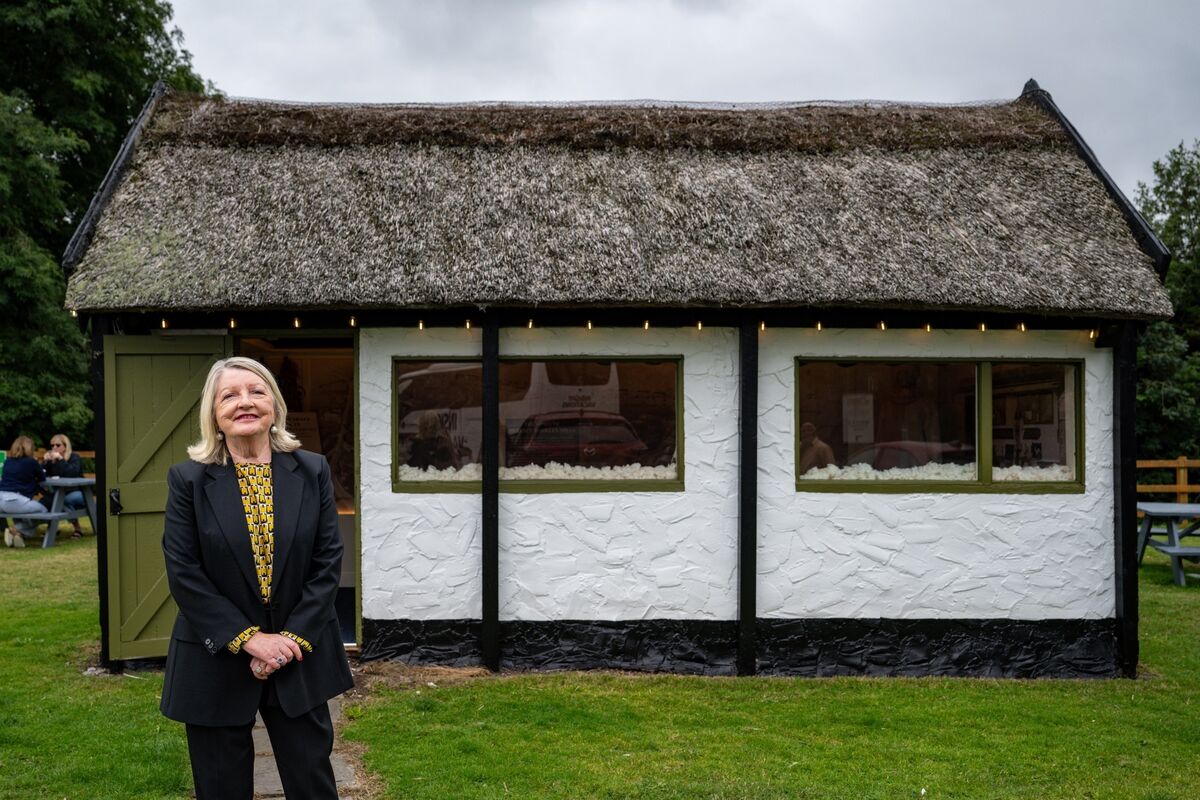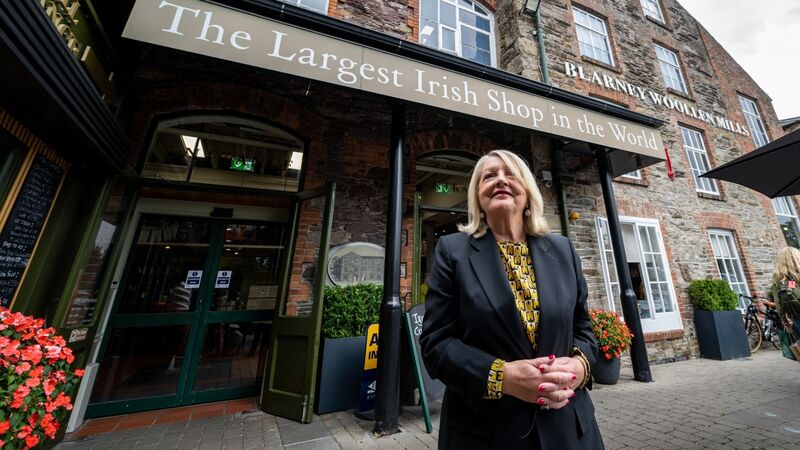IN BUSINESS, they say the customer is always right. An email sent earlier this week from a US visitor gave buoyant affirmation to workers at Blarney Woollen Mills from 7,000km away.
Bill Boyer, from Parker, Colorado, USA, has just returned from his August trip to Blarney — his third trip to Ireland — and complimented the team that his purchase, made in Cork, was on his doorstep on his arrival home in Colorado: “I do have an Aran that is my favourite sweater to this day, that I bought at the Mills almost 40 years ago. Quite warm during our cold Colorado winters. I am working to drop a little weight to fit back into it.”
That sweater has lasted 40 years, and Blarney Woollen Mills is now itself celebrating 50 years since founder Christy Kelleher opened the business on the grounds of the former O’Mahonys Mill.
Taoiseach Micheál Martin will join the company’s chief executive Freda Hayes — one of founder Christy’s seven children — on September 13, along with staff, family, friends, and the local community in an open event to celebrate the milestone, with music and entertainment from 9am.
Rooted in the heart of the village, these days the Blarney Woollen Mills Group is a multi-million-euro transatlantic brand with revenues of more than €50m in 2023.
It’s hard to envision how one of Ireland’s best-known businesses and brands started out working from a tiny, homemade, thatched mobile cottage.
But that’s how Blarney legend Christy and his family first started selling arans and yarns, years before he purchased the mill which now houses Blarney Woollen Mills.
Indeed, years before that, Christy worked as a youngster in what was then known as O’Mahonys Mill — which produced tweeds, textiles, and hosiery.
Christy’s time at the mill came to an abrupt end, and Freda said: “My father had studied mechanics, and people used to ask him to fix their watches. Someone reported him for fixing a watch on the job and he was left go. He was always very embarrassed about that story and never wanted to talk about it.”
Christy was also working part-time with New Ireland, an insurance company, so when he was dismissed from the mill, he was taken on full-time with New Ireland.
“He worked for New Ireland until the day he retired, which was 10 years after he bought the mill,” said Freda.
Christy always had other business sidelines: He also started a business called Blarney Handcrafts — which was on wheels — to capitalise on the tourist influx visiting Blarney Castle.
“My father was from Killard, just outside Blarney village,” Freda said.
“He wanted to start a shop, but he had no money. So himself and his brother-in-law built the cottage on wheels. It took weeks to get it down from Killard because it kept falling into the ditch.”
With Christy working full-time for New Ireland, 16-year-old Freda was asked to step up: “I had just done my Inter Cert. There were seven of us siblings in the family. My three older brothers were all working, and I was next in line.
“The nuns from the school came down and said I should go on and do the Leaving Cert, but my father said: ‘No, I need her to run this business.’”
The first day’s takings was a healthy £14. The Blarney Handcrafts mobile cottage quickly became a familiar sight in the village, selling arans, yarns, and other goods to tourists and locals. The transatlantic fame of the Clancy brothers gave arans an even higher profile, and added a further business boost.
Ever the entrepreneur, Christy embraced the entertainment business, getting involved in the showband era as he bought the Emer cinema and ballroom, holding concerts there on the Waterloo Rd.
Ireland was changing. Tariffs had been steadily removed during Ireland’s economic boom in the 1960s but, consequently, the textile industry of O’Mahonys Mill had declined, unable to compete with cheaper imports.
By the early 1970s, it was in dire straits.
“The O’Mahony family were very well respected in Blarney, and we regarded them as almost like gentry.
“I remember the O’Mahony family brought in consultants from the UK to see if they could save it, but it didn’t survive,” said Freda.
The mill closed in 1973, and the machinery was sold off. The shell of the building was then put up for sale.
“There was a big ‘for sale’ sign, and my father said to me: ‘Will we have a look?’” Freda said.
Selling the Emer Ballroom, scrambling together savings with wife Maureen, and striking a loan deal with the bank, Christy bought the front section of the mill for £70,000, with separate manufacturing buyers buying up other sections of the mill.
Freda said: “There was nothing left inside, and there was about an inch of oil and dirt on the floors.
“We only opened half the ground floor. I remember we dropped big black refuse sacks to make a wall.
“We didn’t have an awful lot of money.”

BUT the fame of Blarney Castle and its proximity saw the new business at the mill thrive.
Tourism in the area had never been properly made an industry. Coach drivers filled with US guests started calling to the new shop at the mill. Business grew quickly, with the knitwear produced on the premises a hit.
A bar was needed, said Christy, as some of the men were frustrated when their wives were shopping: “In those days, you could only get an alcohol licence if you could buy one in a 20-mile radius.
“I said the only way is if we open a hotel.”
In 1978, the name was changed from Blarney Handcrafts to Blarney Woollen Mills.
Having started literally as a cottage industry, it was now a serious concern.
Most of the family had roles running the enterprise. Over time, Blarney Woollen Mills bought out the next-door manufacturing businesses and took over the whole mill, and would add the former plastics building across the mill.
Alongside the Blarney Woollen Mills products, Kevin Kelleher, Freda’s brother, started running the Le Tricot Marine brand: Sailing-themed clothing. Kevin passed away in 2021.
The company reached out across Ireland. In the 1980s, it bought the Donegal Bay brand — rebranding as Fisherman out of Ireland, an important employer in the gaeltacht in Kilcar.
Christy never had a direct role in day-to-day business affairs in Blarney, but was a familiar face, meeting coach drivers as they brought visitors from the castle.
Freda’s sister Bernadette previously recalled Christy “didn’t drink or smoke, was happy enough to be able to buy the Cork Examiner every day and put petrol in his car. He always did like a nice car though.”
Christy died in 1991, leaving a business legacy which had expanded into am international venture.
Succeeding Christy, and plotting the course into the millennium, led to conflict in the family.
“It’s understandable in a family, you’re all equal,” said Freda. “And for one person to be the boss, that does not always go down well. My family had ideas for how to run a successful company, and some of my family wanted change and maybe to rotate the chief executive on an annual basis, which I wouldn’t agree with. So I left in 1992.”
Freda started her own homewares and fashion business, Meadows and Byrne, opening her first store in the Methodist Hall on Academy St.
It was a bold venture, but Meadows and Byrne became a huge success in Celtic Tiger Ireland.
Back in Blarney, disagreement on the direction of the company saw a further shift in 1999.
“My two sisters split from my brothers [Marian O’Gorman became chief executive of Kilkenny Design], and eventually I came back into business in 2000 with my brothers,” Freda said. “That’s what’s going on today, and how and Meadows and Byrne and Blarney became one.”
Today, alongside the 60,000ft Blarney flagship, Meadows and Byrne has 13 shops nationwide. The hotel on the grounds in Blarney is thriving, with 91% occupancy.
The Blarney Wollen Mills knitwear factory continues, sitting above the shop. Sales trends have changed.
Freda said: “Online is much more important now. My son runs blarney.com and that sells about 80% to America, 20% to Europe.
“Since covid, the whole restaurant and hospitality side has doubled. After covid, it has become a kind of a meeting place. We now have a huge local trade, who come in here every day of the week, and all year round. Blarney is much more a domestic business today than it was 30 years ago.”
The Blarney Group employs about 520 people, with about 160 in the HQ.
Working at Blarney Woollen Mills remains a rite of passage for some locals, many following their parents into a role.
Freda remains as busy as ever at the helm of Blarney.
She has been on the board of industry and education bodies such as University College Cork and Aer Rianta. These days, the CEO’s focus is on the Blarney Group. Like Christy, the coach drivers all know her on first-name terms.
“I am wherever I need to be,” she said. “When you’re running your own business, that’s what you have to do.
“We will probably open two or three more Blarney stores. I’d like us to go back into Dublin with the Blarney brand. We look at all opportunities as they come.”

Unlimited access. Half the price.
Try unlimited access from only €1.25 a week
Already a subscriber? Sign in
A collection of the latest business articles and business analysis from Cork.
CONNECT WITH US TODAY
Be the first to know the latest news and updates















